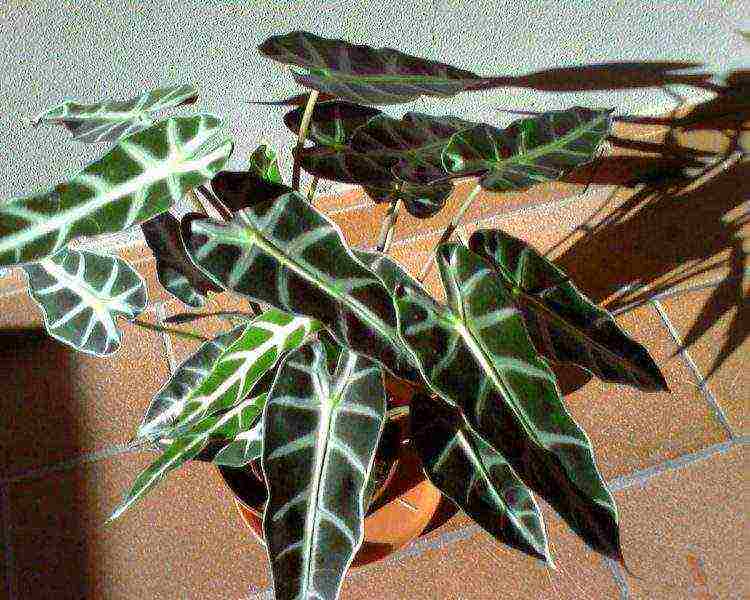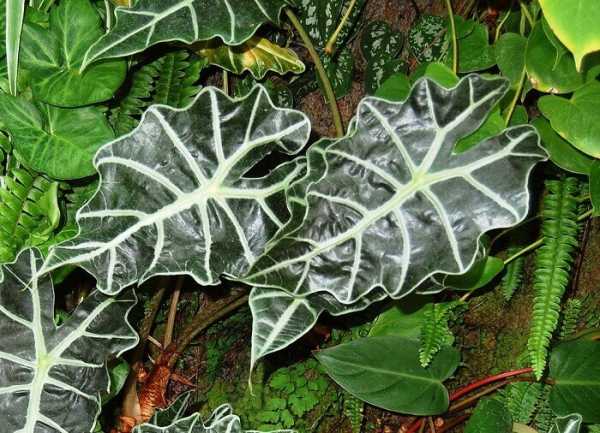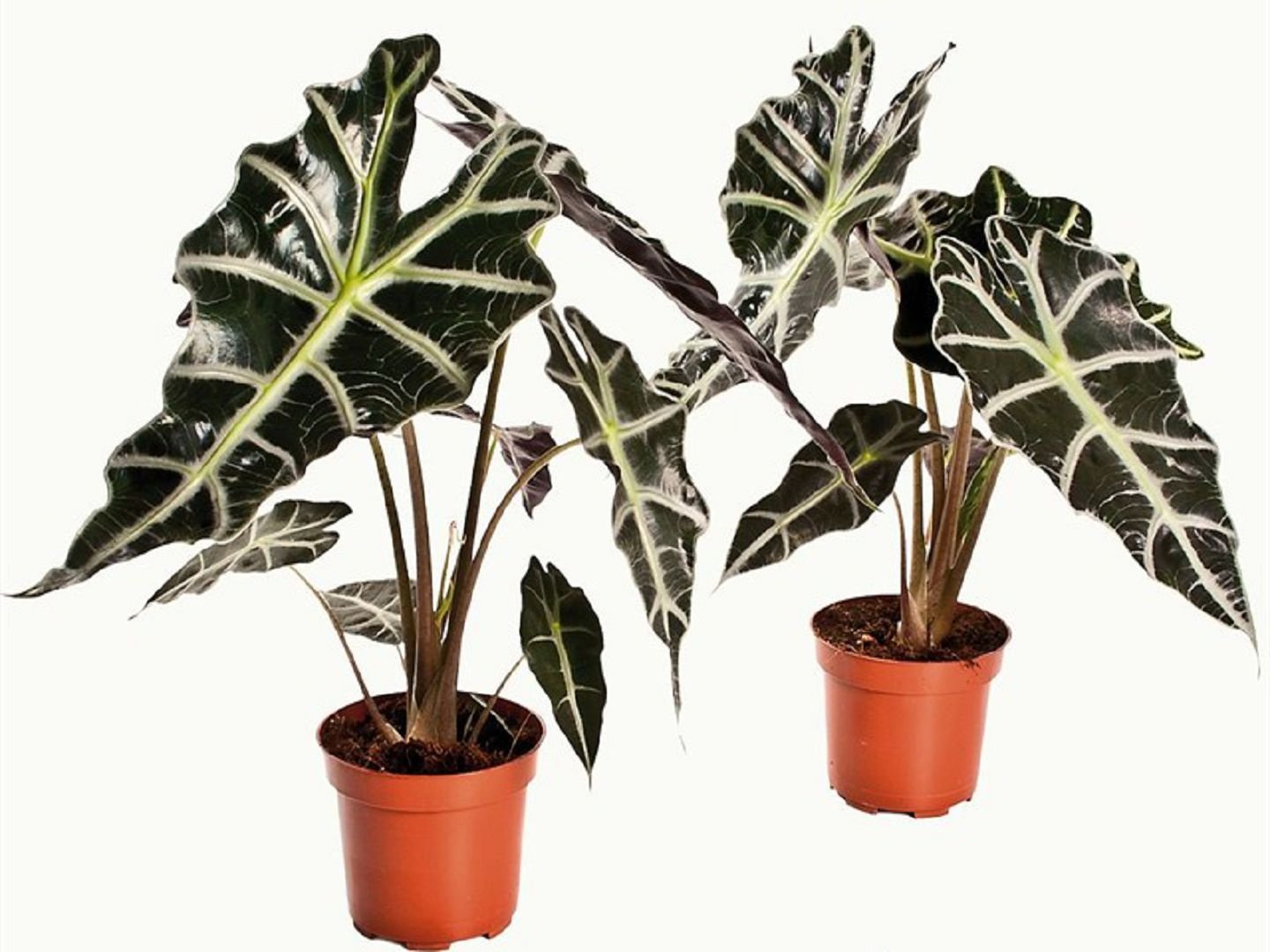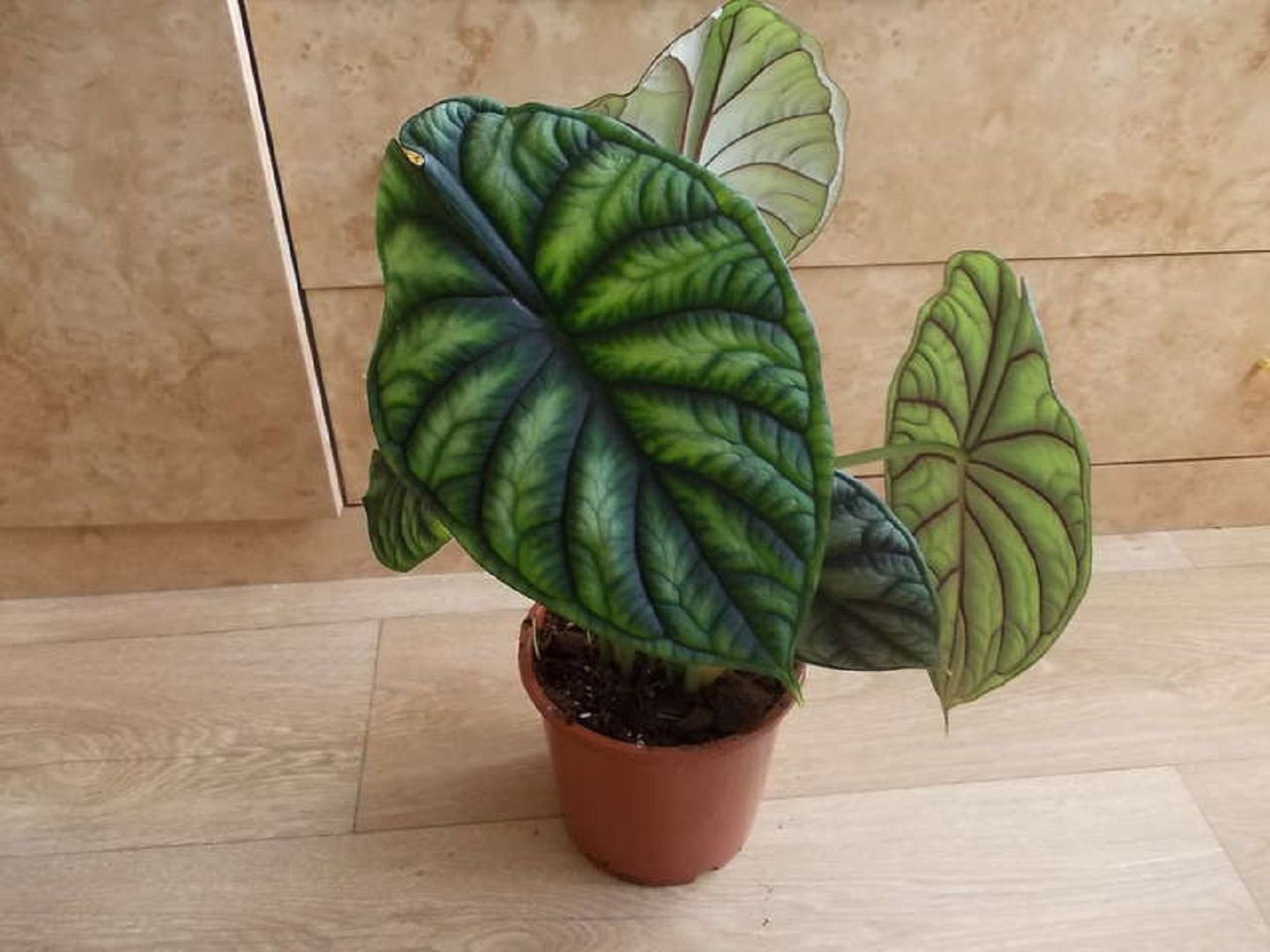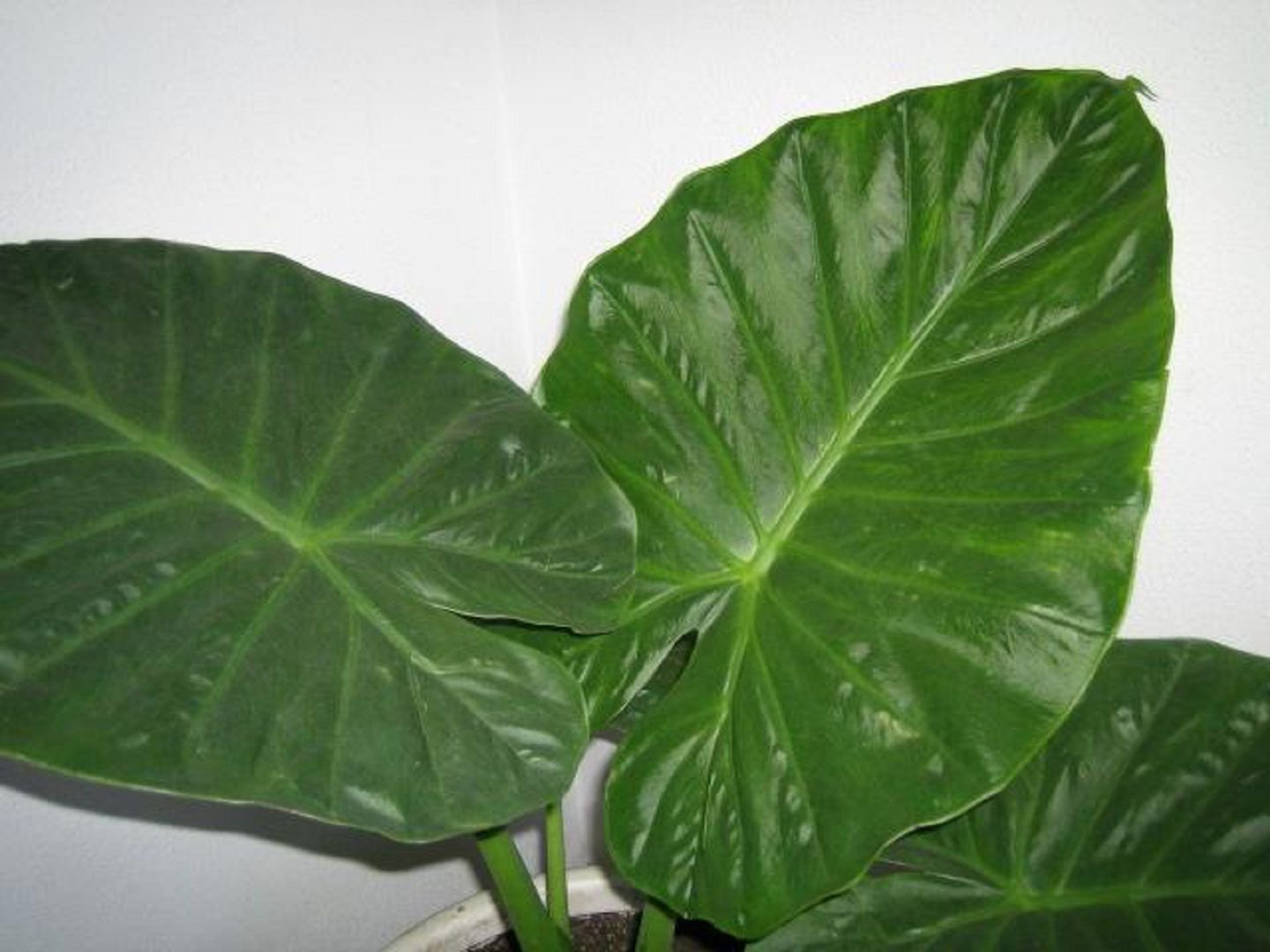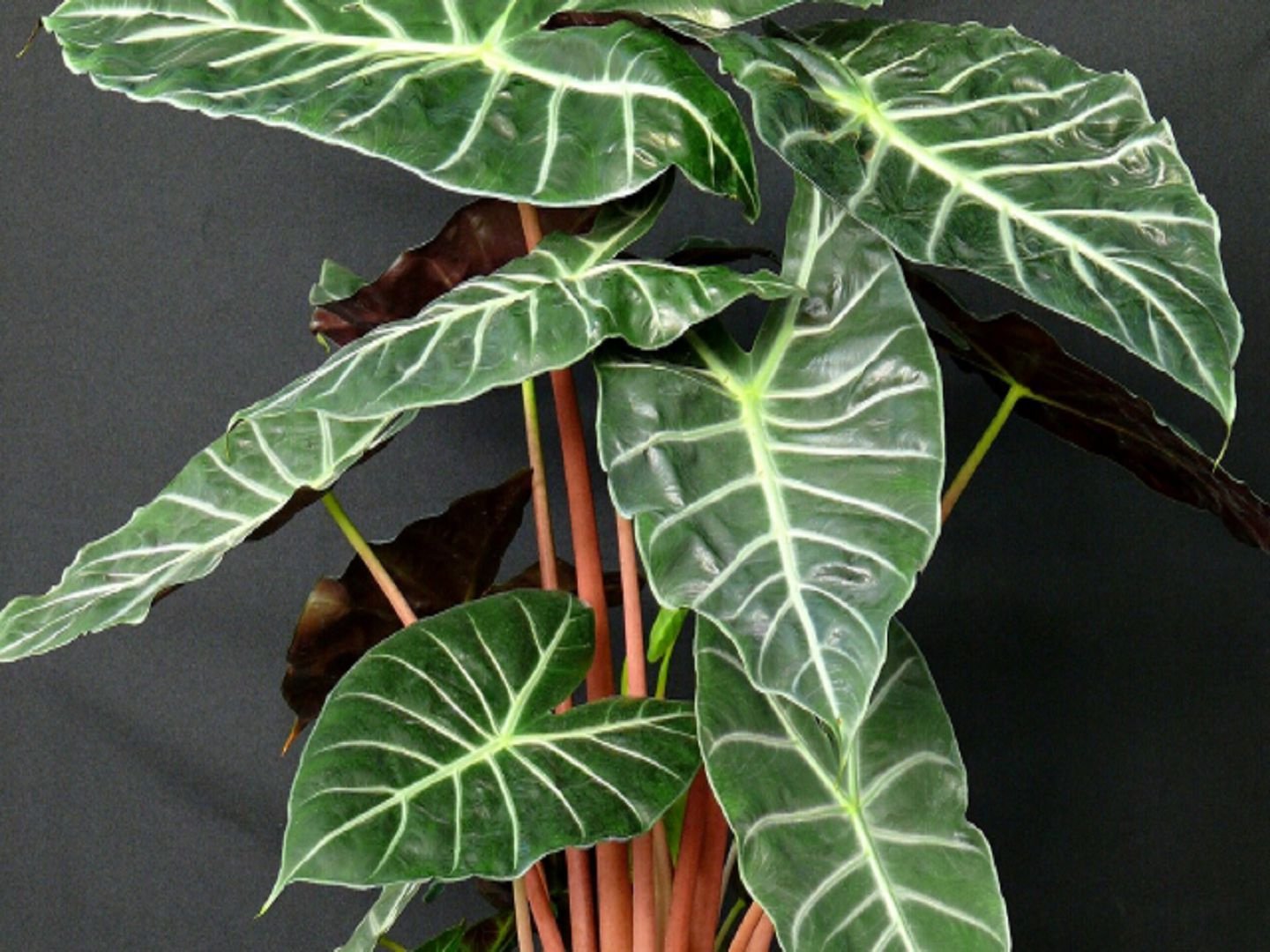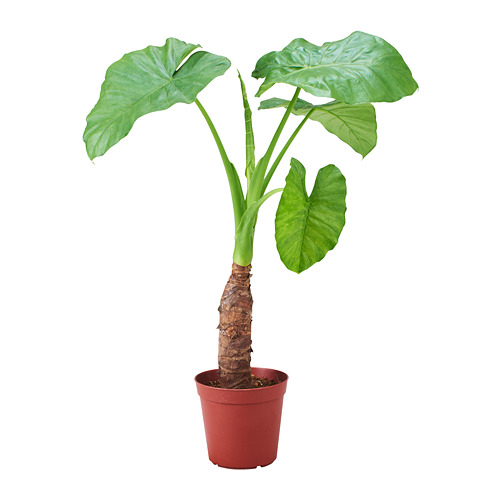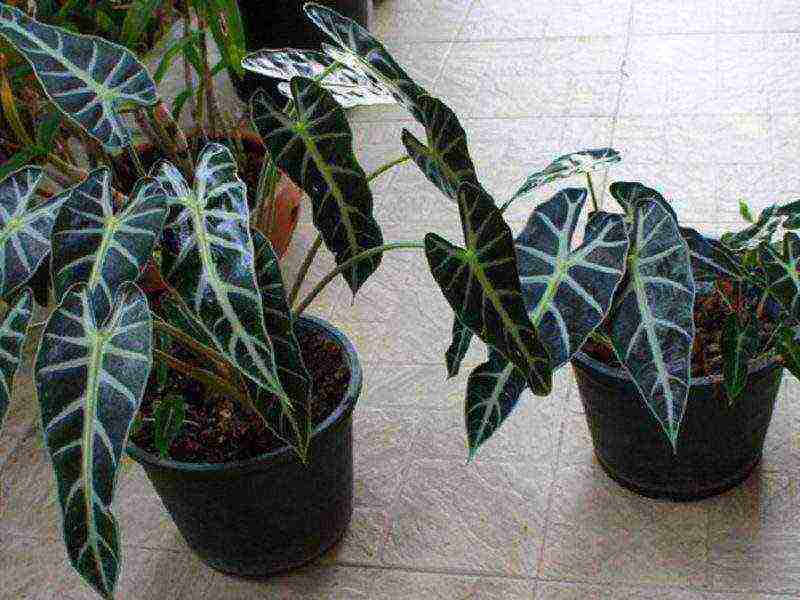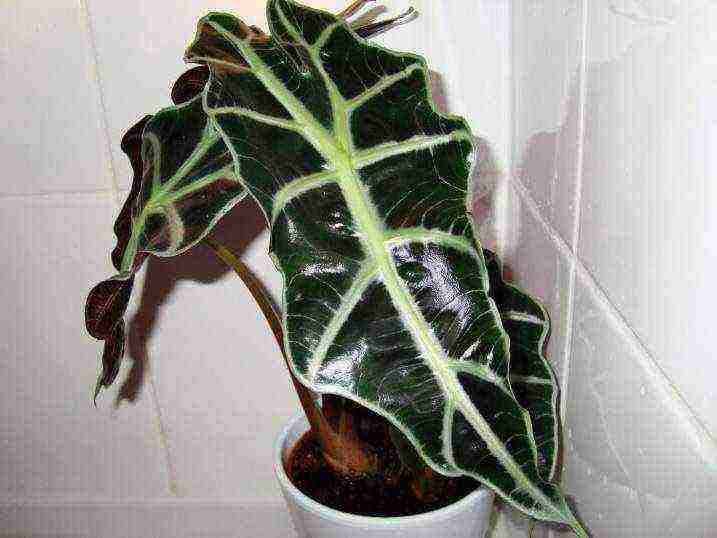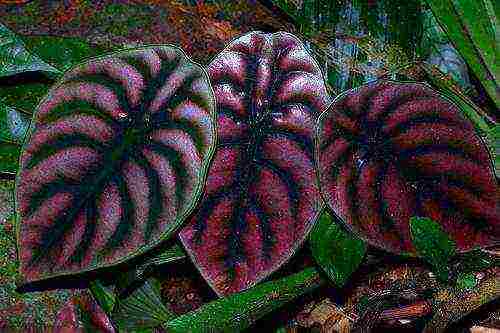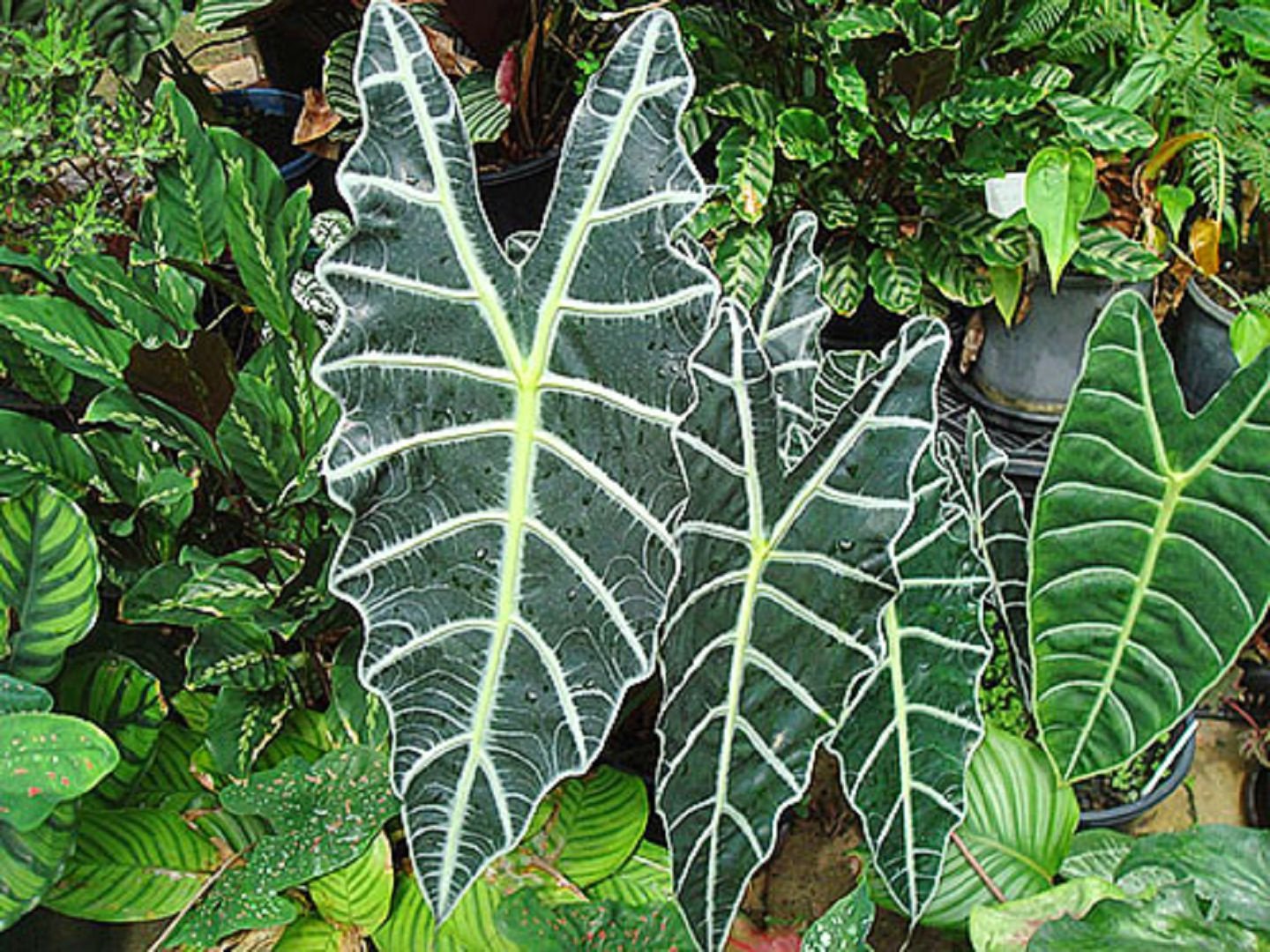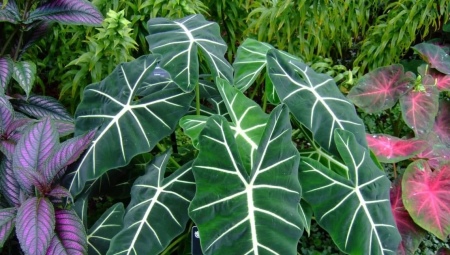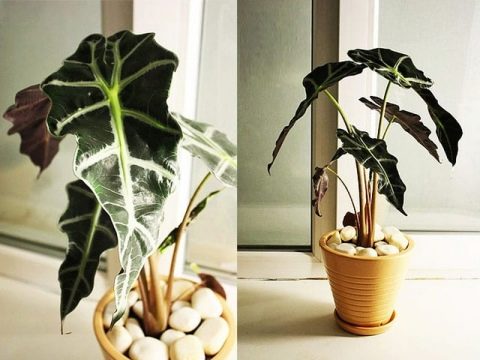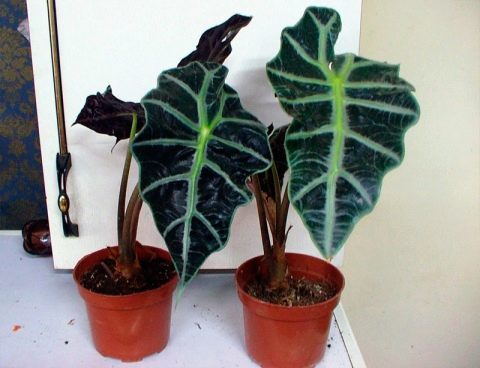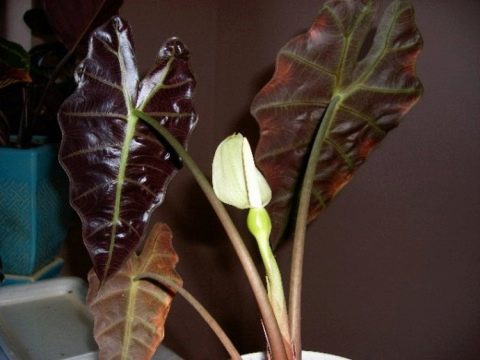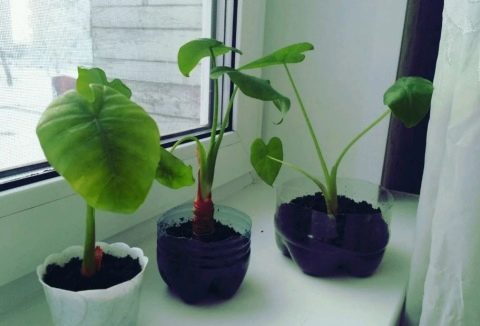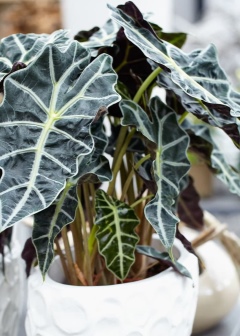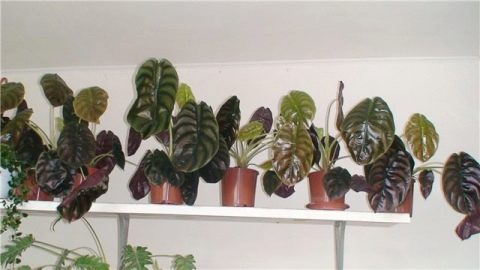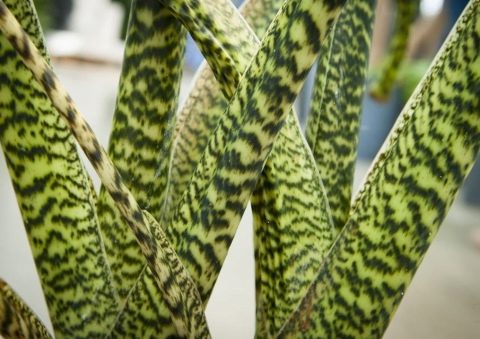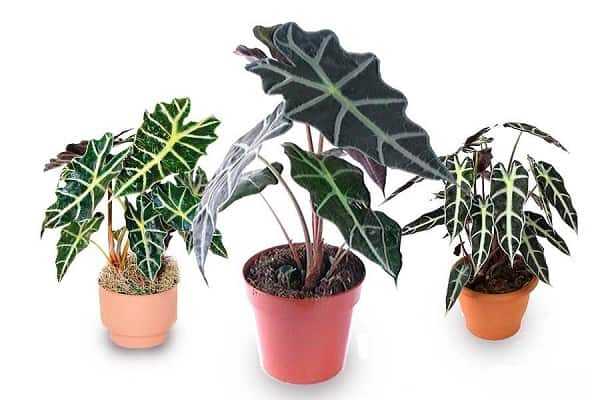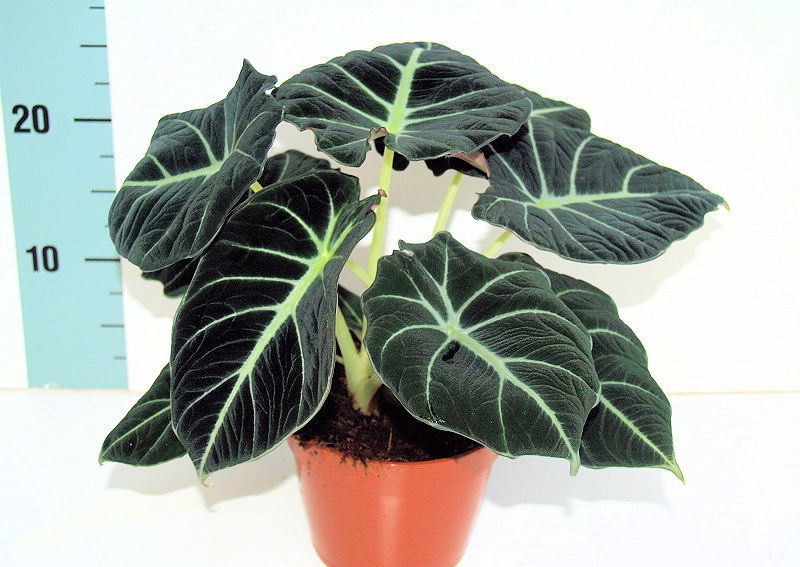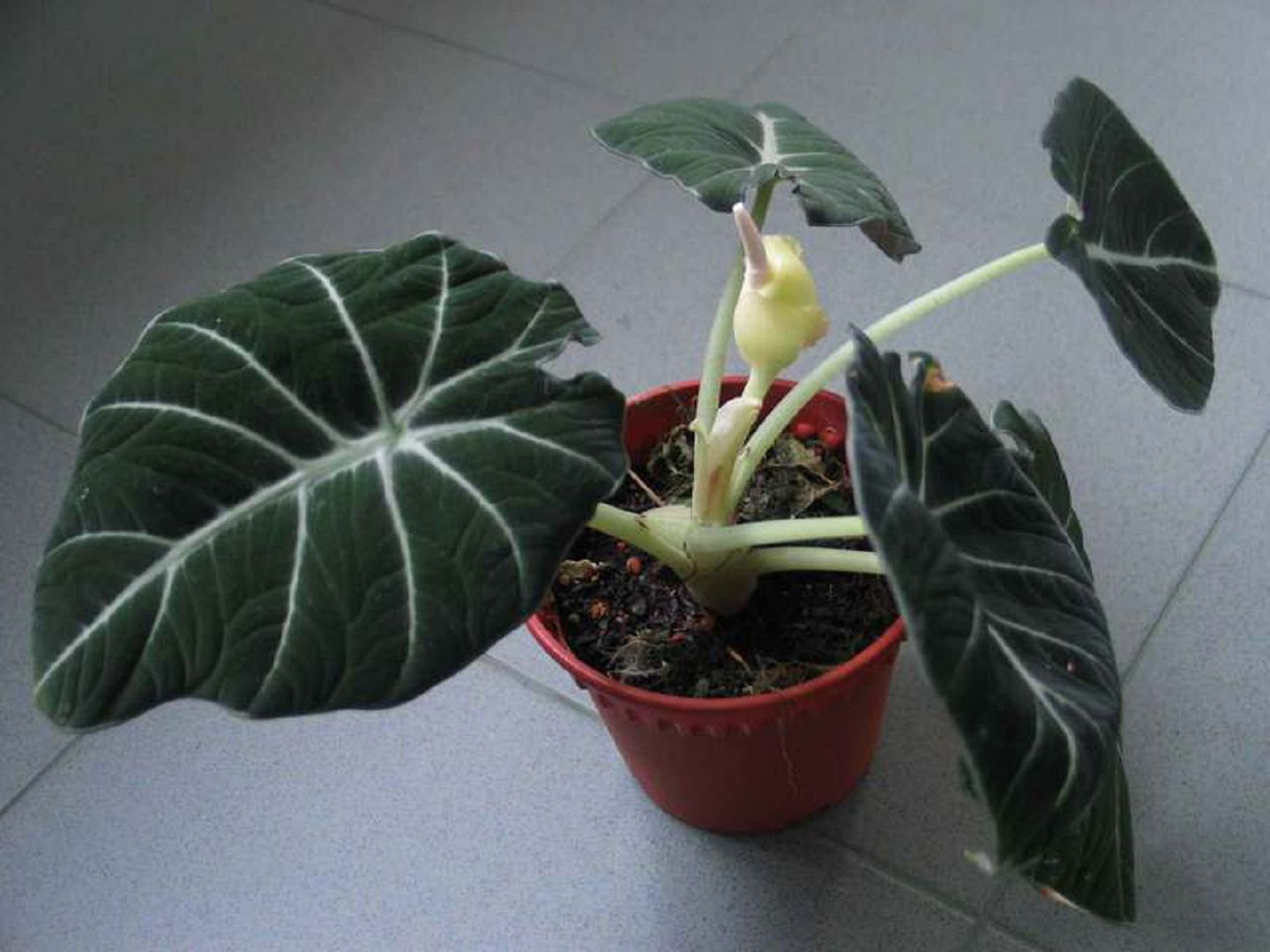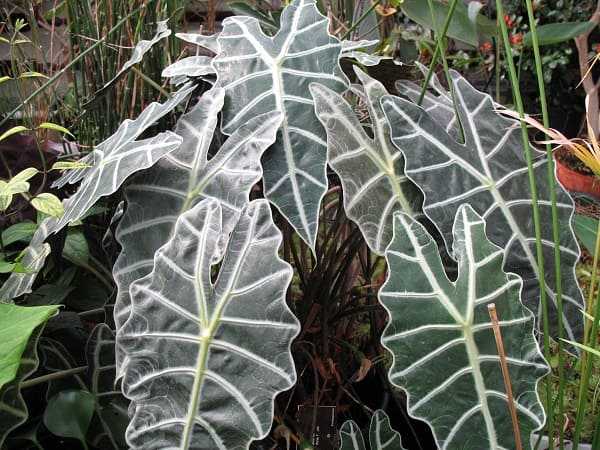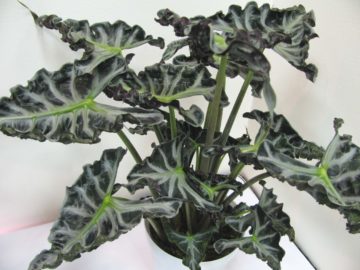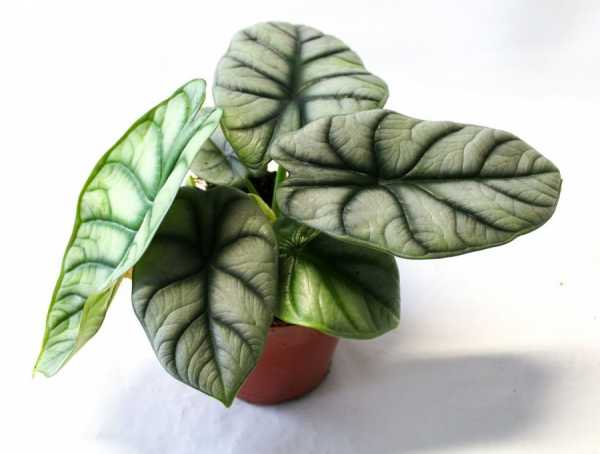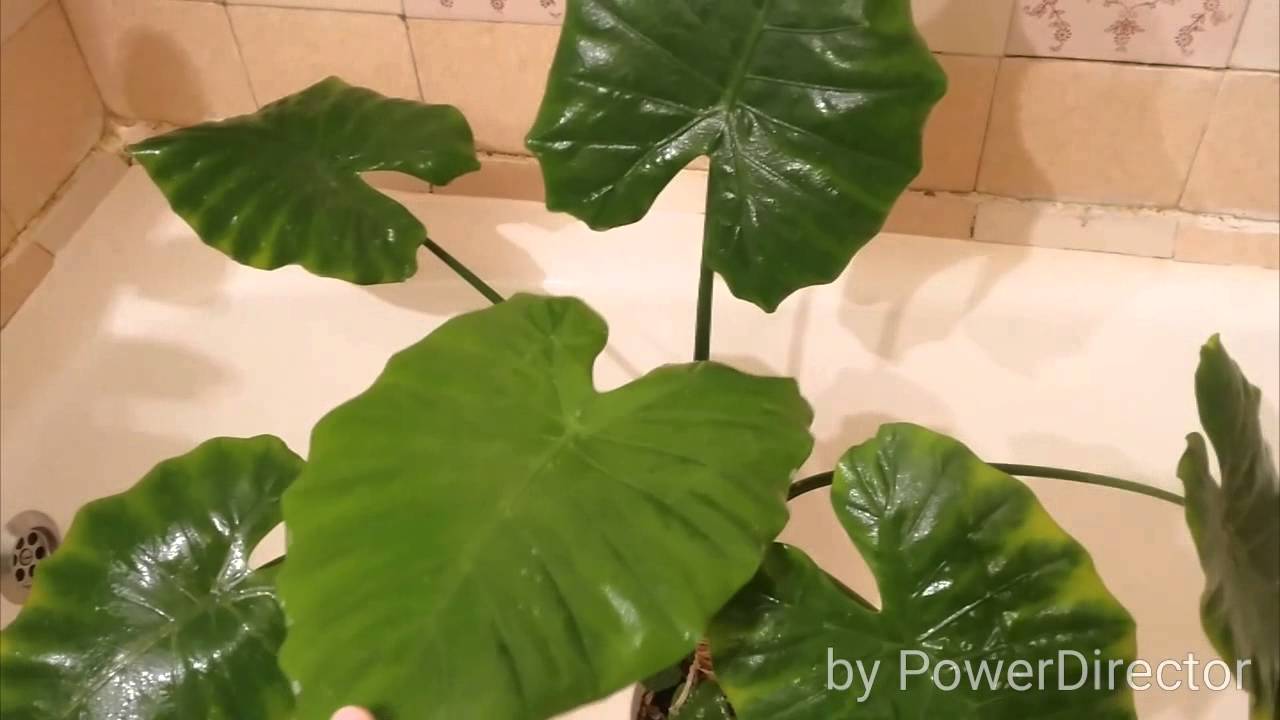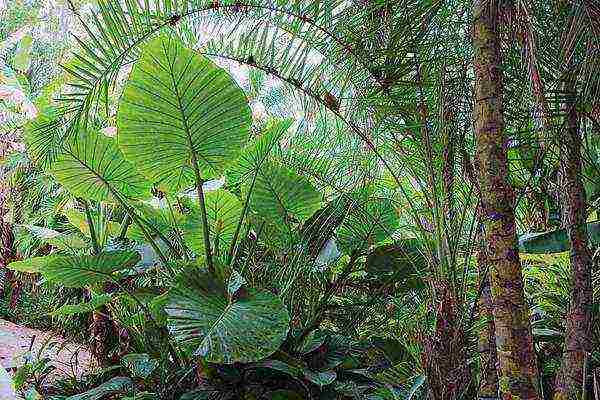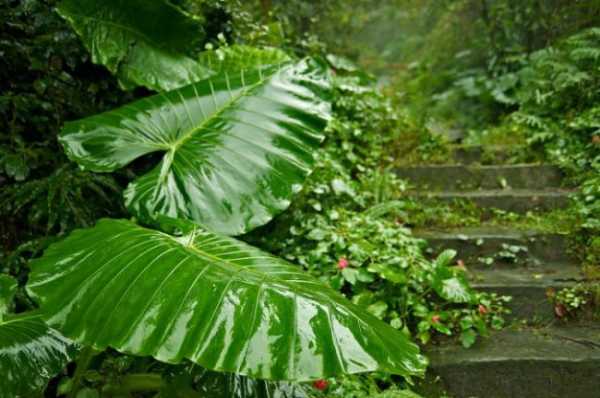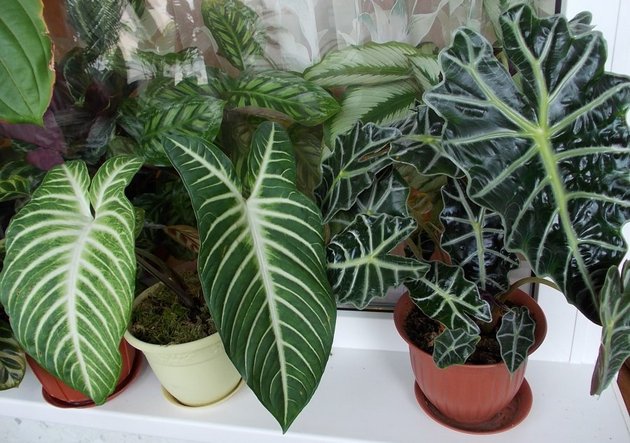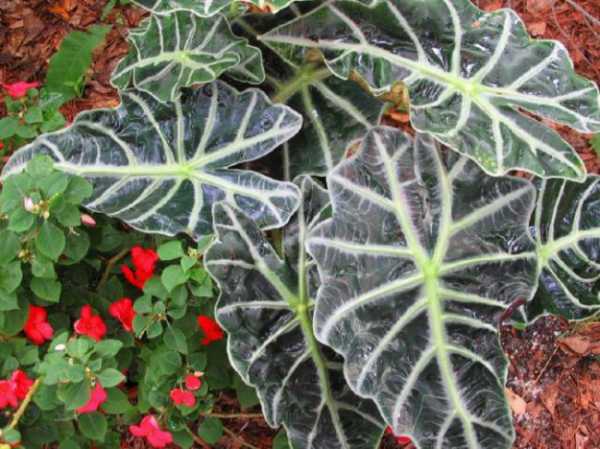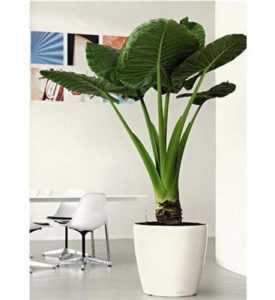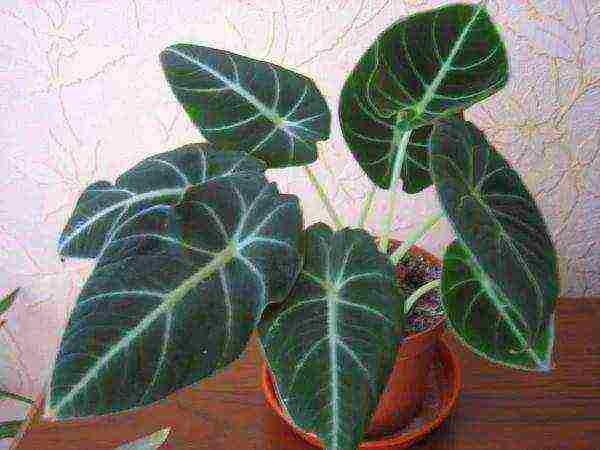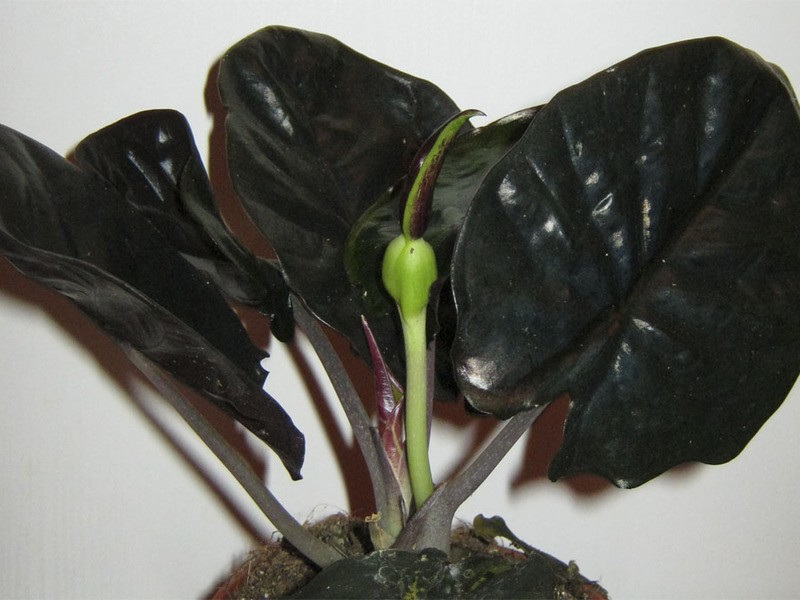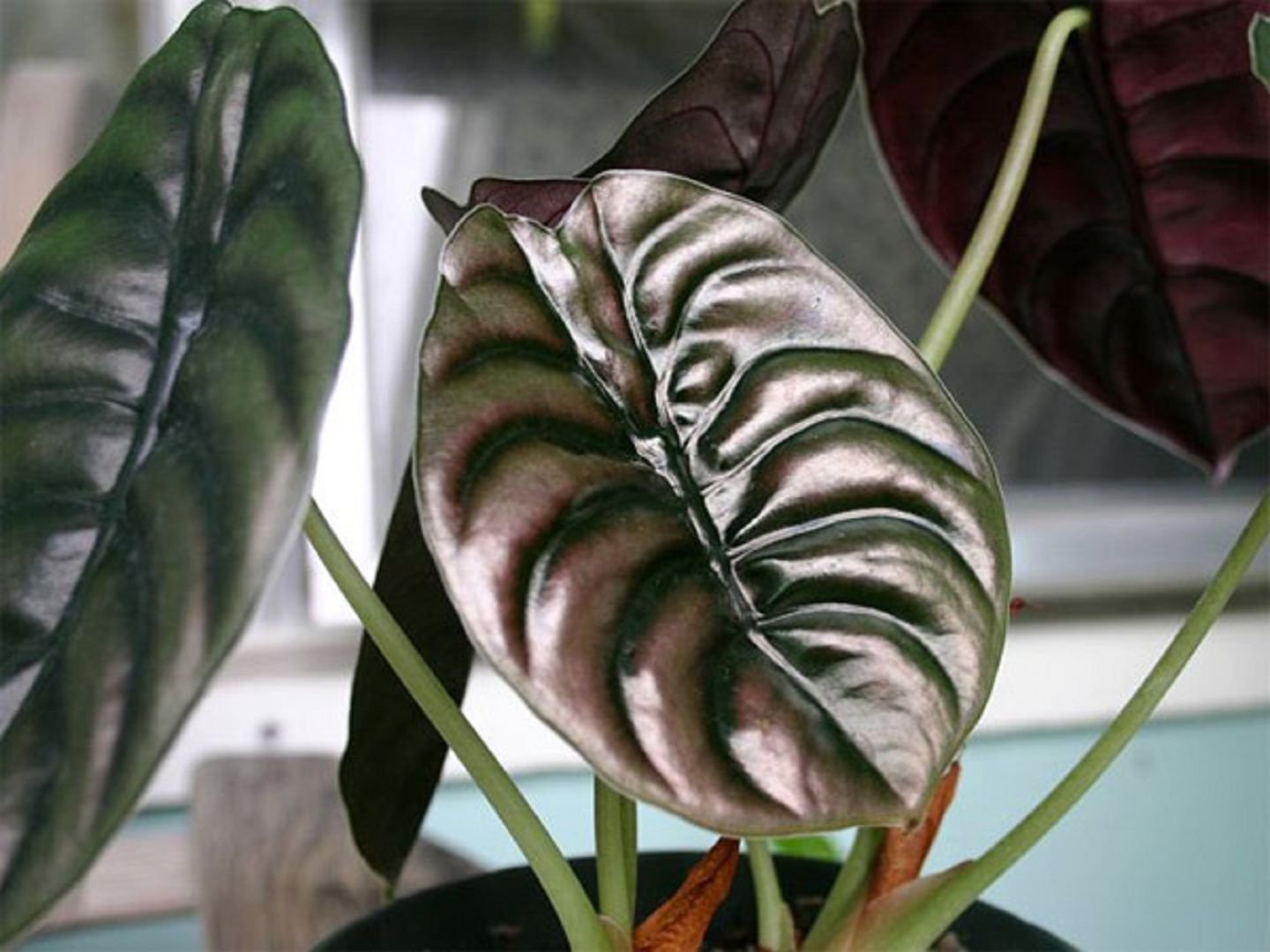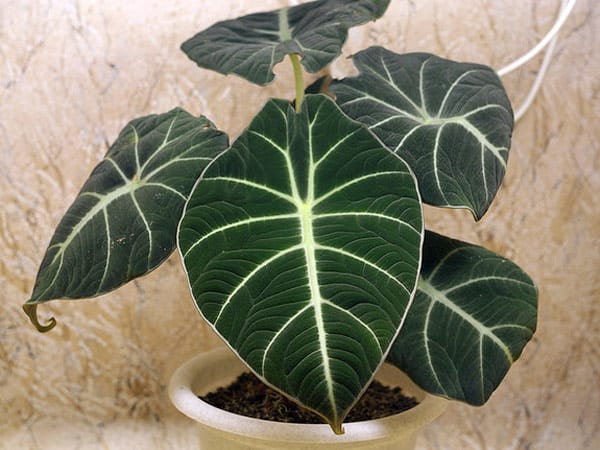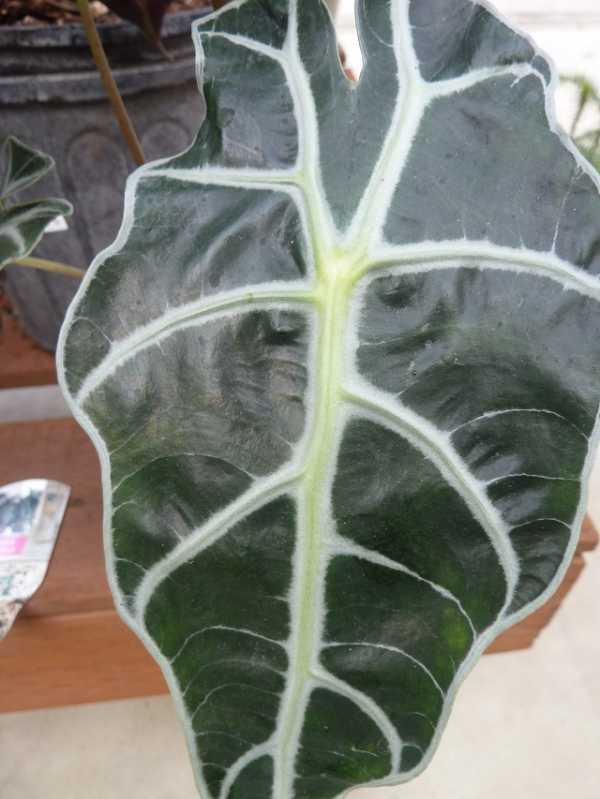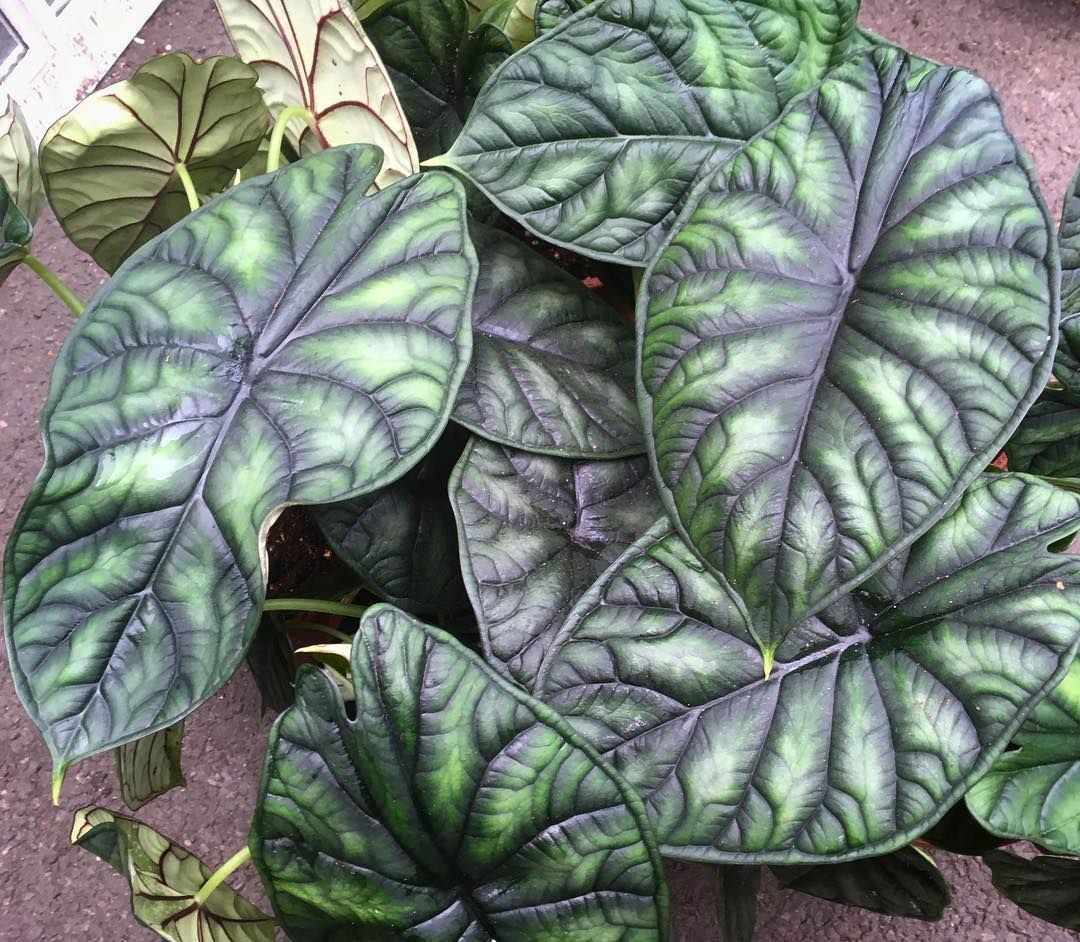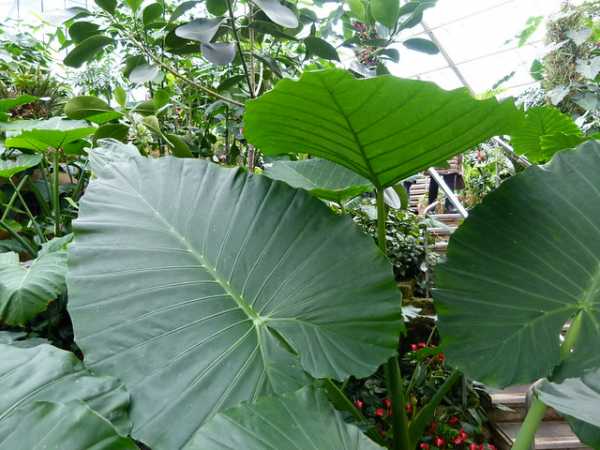Care features
Home care for alocasia includes the following procedures:
- correct watering;
- timely fertilization;
- transfer.
Additionally, it is also necessary to cut off the formed peduncles, since at this time alocasia actively sheds its leaves. The cut should be covered with charcoal powder. You can give the plant to bloom, but in this case, it is necessary to cut off the peduncle immediately after the end of the flowering period, so as not to further deplete the alocasia by ripening the berries.
Watering
In the spring and summer, alocasia needs abundant and regular watering. In this case, it is recommended to moisten the soil as the top layer dries out. The water from the pallet must be poured out, not allowing it to stagnate. Boiled water at room temperature is suitable for watering alocasia.
In winter, you need to water the flower no more than twice a week. If the alocasia pot is located in a cool room, the soil should be slightly dried so that the roots do not start to rot. In winter, it is recommended to water the plant with warm water.
Top dressing
In spring and summer, the flower must be fed once every 3 weeks. As a fertilizer, it is recommended to use an organic or mineral mixture intended for indoor plants. It is desirable that nitrogen and potassium are present in the top dressing.

You can alternate fertilizer "Leaf" (1 tbsp. L. For 3 l of water) with "Agricola for decorative leaf plants" (1 tsp. For 3 l of water). In autumn and winter, the frequency of fertilizing should be reduced to 1 time in 6 weeks.
Transplant: instruction with photo
Young plants need an annual transplant. It is recommended to carry it out in the spring. It is enough to transplant adult specimens into a larger pot once every 3 years.
Sequential alocasia transplant is carried out as follows:
| Step number | Actions | Photo |
| 1 | Choose a container, the diameter of which will be approximately 3 cm larger |  |
| 2 | Fill the selected pot with drainage |  |
| 3 | Add prepared soil on top | 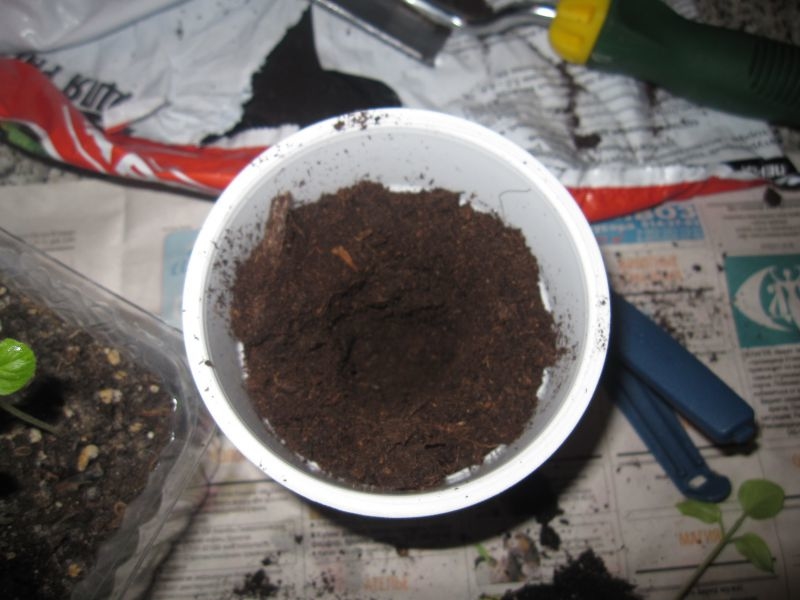 |
| 4 | Remove the plant from the previous container, gently holding the top of the soil and the stem of the flower with your fingers |  |
| 5 | Shake off loose soil, taking care not to damage the root system | 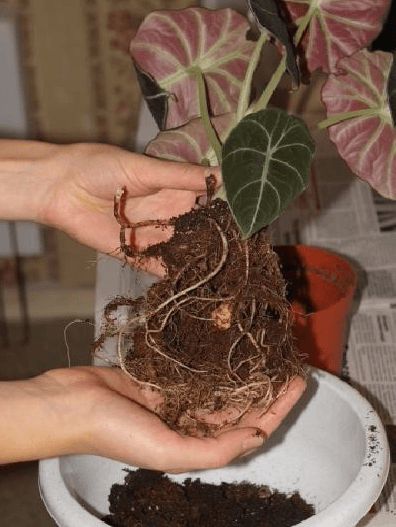 |
| 6 | Place the plant in the center of the pot, gradually add new soil around the roots and slightly compact the soil |  |
Growing problems: table of signs and remedies
Problems can arise when growing this tropical flower, but most often they appear if the alocasia has not been properly cared for.
| Problem | Reasons for the appearance | Ways to rectify the situation |
| Lethargy leaves |
|
Transplant the plant and ensure it is properly watered |
| Drying of the edges of the tips of the leaves | Dry indoor air | Humidify the air with a spray gun more often |
| Slowdown in growth | Lack of nitrogen | Feed the plant with nitrogen fertilizer. Dosage - 1 g per 1 liter of water |
| Yellowing of leaves |
|
Move the alocasia pot to a draft-free room. Water the plant only with boiled water |
| The appearance of dark spots on the leaves |
|
Shade the flower and move the pot to a warm room |
| Shedding leaves |
|
The peduncle must be removed, and the plant must be fed with complex fertilizer |
| Fading of leaf plates | Insufficient lighting | Provide additional artificial lighting for alocasia |
| The appearance of water droplets on the leaves | Excess moisture | Drain the sump and let the soil surface dry |
Healing properties
Alocasia can treat various ailments. The therapeutic properties of the plant are due to its composition, which contains the following substances:
- coumarins;
- alkaloids;
- hydrocyanic acid;
- corrosive sublimate.
Properties useful for the human body:
- suppression of the growth and development of hematomas;
- providing an analgesic effect for pains of various etiologies and locations;
- expectorant effect;
- activation of the process of cell and tissue regeneration;
- wound healing effect;
- anti-inflammatory and anti-allergic effect.
Attention! Despite the fact that alocasia is actively used in folk medicine, it has not received the official status of a medicinal plant. This is explained by the fact that it contains poisonous substances.
Application of alocasia tincture
If alocasia house plant is grown on the windowsill, the treatment of many diseases can be carried out using a tincture prepared on its basis. Recipe:
- cut into small pieces the old leaf plate, which has already begun to turn yellow;
- pour 500 ml of vodka;
- insist 14 days in a dark place.
Application of alocasia tincture:
- Diseases of the thyroid gland. Soak gauze folded in a few words in a liquid, attach to the neck, cover with a film and a scarf on top. Keep the compress for 5 hours, the course of treatment is from 7 to 10 days.
- Paralysis, numbness. Alocasia tincture is rubbed into the affected area up to 3 times a day.
Important! Given the toxicity of the plant, it is strictly forbidden to change the recipe for the preparation of the tincture, to increase the dosage and frequency of use of the product.
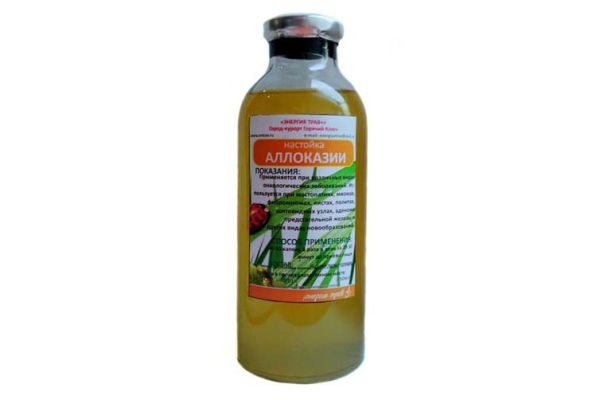
You need to be careful with a medicine based on a plant, otherwise it can harm
Alocasia care and reproduction
This type of plant looks best in spacious rooms, in the bathroom, since there are the most suitable conditions for it. Another place for comfortable flower maintenance is a spacious kitchen. The only obstacle to keeping in the kitchen may be the lack of a draft-free zone. The slightest breeze of cold air can destroy a beautiful flower.
Can alocasia be kept at home? Of course, you can, if you follow the requirements for caring for a home plant. It should be noted that this pet will need tall dishes, for example, glossy pots, made to match the leaves. To create moisture, you can use an aquarium in the composition or create a picturesque corner of expanded clay, sphagnum moss.
Lighting requirements
Alocasia for home care needs bright diffused light without direct sunlight. This is usually the well-lit east and west side of the room. In winter, the plant must be moved to the lightest part of the house. When creating a composition in a dimly lit part of the house, it is necessary to create an artificial light flux.
Requirement for air humidity and room temperature
The most demanding air humidity is Amazonian and weeping alocasia, optimally 80%. They are kept only in the kitchen. The rest of the domesticated plants tolerate some dryness, up to 50% in summer and up to 40% in winter. They create additional moisture using pallets with evaporating moisture, spraying with warm water and wiping the leaves with a wet cloth. But for all the demands on humid air, the roots should not bathe in water.
Watering mode
Alocasia is a moisture-loving flower, but it needs systematic moderate watering without waterlogging. In this regard, it is unacceptable that there is stagnant water in the sump under the drain hole. At the same time, underfilling can lead to yellowing and shedding of leaves, which deprives the flower of its beauty. Therefore, in summer, moderate watering is carried out with warm, settled water every other day, and in winter they water it when the top layer of the earth dries up, about once a week.
Simultaneously with watering and wiping the leaves with a damp sponge, you should pay attention to whether pests have settled on the bush
On this topic:
BACK
FORWARD
1 out of 5
Soil, fertilization, top dressing
Alocasia requires an acidic soil with a pH of 5.5 - 6.3. Such a composition is created on the basis of low-lying peat, and forest humus, taken immediately under the litter. A handful of needles added to the substrate will help create the desired acidity. On this basis, after steaming and disinfecting, the desired mixture is created in different proportions. It is proposed, as an option, this:
- low peat - 2 hours;
- leaf humus - 6 hours;
- sand - 1 tsp;
- sphagnum moss - 2 hours:
- crushed charcoal - 3 tsp
Specialists in the cultivation of alocasia advise to pour a tablespoon of complex fertilizer on the bottom of the container immediately onto the expanded clay layer and sprinkle it with a substrate. This will allow you not to worry about feeding for a year after plant transplantation. They consider this way of feeding alocasia during care and reproduction more acceptable.
If the soil is not filled with fertilizer, then systematic fertilizing watering is required. In spring and summer, during intensive growth, once every three weeks, you need to nourish the plant with nitrogen components. Potassium salts are also required. In the complex it is potash nitrate, but it is better to take specialized liquid dressings for home flowers. For example, "Agricola" for ornamental plants diluted with a teaspoon per 3 liters of water. In winter, fertilizing watering is done twice less often. For young plants, phosphorus is important, which must be given in soluble salts. They contribute to the rapid development and strengthening of the root system.
The choice of dishes is also important. The peculiarities of alocasia require that the root grow deep, and when planting, the roots are directed vertically. Therefore, tall, narrow vessels with good drainage are chosen. The new container should be 3 cm larger than the old one.
Landing
Germinating seeds is the longest and most laborious way to get a plant. In addition, the seeds of alocasia quickly deteriorate and it is rather difficult to determine when buying.
You should carefully choose seeds in the store, while you need to pay attention to the following points:
- The packaging must be strong and free of any defects.
- The information on the packaging must be clearly legible, the labels must be clear.
- The expiration date should be normal.
 Seeds should be sown in spring when the air temperature gradually rises and daylight hours increase. Germination requires at least ten hours of intense lighting. If sowing is planned in February, then additional lighting will be required.
Seeds should be sown in spring when the air temperature gradually rises and daylight hours increase. Germination requires at least ten hours of intense lighting. If sowing is planned in February, then additional lighting will be required.
Seed soil is required the same as for adult plants.
- Seeds should be sown on damp soil without burying them.
- From above you need to cover with glass and put on the windowsill.
- The seeds must be periodically moistened with a spray bottle, since the soil must not be allowed to dry out.
After about 20 days, they will hatch if the seed was of good quality. When sprouts appear, they need daily ventilation.
If you can't grow alocasia from seeds or it seems too difficult, you can ask your friends for a tuber or leaf cutting of a plant.
Pot selection
Alocasia needs a tall and not too wide pot. You can even use narrow, spacious pots, because the plant has long roots. If you plant this plant in a wide and low pot, then very soon you will need to transplant into a new one, since the roots will grow into the drainage holes.
As for the choice of pot material, this moment does not matter. It can be of any material. However, the best option is always a ceramic pot without glaze.
What should be the soil?
The soil for this plant should be light, loose and airy.It should also dry out quickly, as excess moisture causes the sensitive roots of the plant to rot. A good mix for alocasia can be made by mixing:
- Horse peat.
- Ready-made soil for orchids.
- Garden land.
Such a mixture will be an excellent soil, which contains the nutrients necessary for the plant. And it will be able to develop correctly and not lack oxygen access.
Alocasia home
Among flower growers, the name "elephant ear" has stuck. An unusual plant is very much disliked for its toxicity and therefore it is not recommended to grow in houses where there are small children or animals. You should be especially careful when transplanting a flower and be sure to use gloves. The most poisonous variety is Copper-red.
Appearance
In nature, there are about seventy species of this plant. All of them are united by external similarity in key indicators.
- Inflorescences are small, beige, white or pink. Its shape is reminiscent of an ear of corn.
- The leaves are large, oblong and pointed towards the end. The color of the leaf plate is unusual, of a dark green hue with beige veins forming a magnificent pattern.
- The root system is tuberous. The roots have a light color and elastic structure.
- Leaf petioles are dense and rather long. Due to the water estuaries, Alokazia retains water in conditions of high humidity.
Only a few species of this plant are grown indoors.
Plant species
Some growers try to keep several varieties of Alokazia at once. They all have an attractive appearance, but differ in the shape of the bush. The most popular among them are:
- Sander. This variety has long, narrow leaves with notched lobes. Their color is dark with a silvery tint, and the petioles are long and brown.
- A short ornamental shrub of the Black Velvet variety is very popular in home cultivation. The heart-shaped leaves have a velvety surface. It blooms with pink flowers collected on the cob.
- Large-root Alokazia grows up to two meters high. It blooms in large cobs forming a veil. Their length reaches thirty centimeters. The leaves are long and wide, the shape of the plate is oval. The fruits of this variety are also large, rich red.
- Alocasia Polly grows up to seventy centimeters in height. On the leaves it has streaks of bright white color, and the leaf blade itself is pointed. Polly is the only one of all types of Alokazia, which can please with its flowering. Her flowers are small, collected on the cob. This hybrid variety has a delicate, pleasant aroma.
- Amazonian Alocasia has long petioles reaching sixty centimeters in height. The leaves are dark with lateral veins, their shape is elongated and pointed. The cob-shaped inflorescence is about ten centimeters long. It blooms with pink flowers with a veil. When grown indoors, it does not bear fruit.
- The Low variety has an unusual and very attractive appearance. This flower has leaves with bright white veins, and the underside of the plate has a purple tint. The shape of the leaves resembles arrows. Lowe can reach a height of one meter.
- Fragrant Alokazia grows up to one meter in height. Its leaves are large and fleshy, and the petioles are long. It blooms in a pale blue color, which is extremely rare at home.
- Klobluchkovaya Alokazia is also suitable for a home greenhouse. Its height usually does not exceed eighty centimeters. The leaves are bright and dense, slightly pointed at the tips.
- Poisonous Copper Red is not recommended for home cultivation. It has bright emerald leaves, which are colored dark green on the inside.
All other varieties are slightly poisonous and may well be grown in home greenhouses. What is required for alocasia flower?
Tincture application
An alcoholic infusion of petioles and leaves can be used externally for rubbing or compressing. It is believed that he can:
- help with inflammation and swelling;
- starts the process of tissue repair;
- reduces joint pain.
Alocasia tincture is prepared by grinding the plant in a ceramic bowl. No metal tools are used. The ratio of crushed gruel and alcohol is 1: 1. The resulting solution is stored in the dark for 21 days.
Attention! Ingestion in drops, the amount of which is determined by a doctor who knows the dosage. Considering that this type of plant is not recognized as medicinal, and the juice contains mercury chloride and cyanides, the treatment is questionable.
Alokazia Polly: care and features
Flowers require proper care for normal development.
Consider how to care for a plant? Much attention should be paid to irrigation, lighting, fertilization, temperature conditions
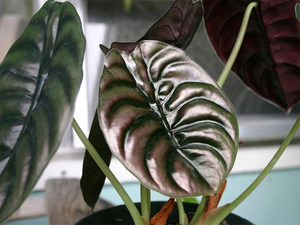
This flower is quite picky about natural light.
Watering
The Alokazia pot is best placed on a pallet already covered with moistened pebbles or expanded clay. The bottom of the pot should not come into contact with water, this will cause rotting of the roots. Watering is carried out the next day after the top layer of the earth dries up. This rule is valid for summer, winter and spring soil moisture. The amount of watering of the flower will depend on the temperature in the room, the intensity of the light and the humidity in the air.
Soil for Alokazia and groundbait
For the proper development of this flower, a moisture-absorbing and well-aerated soil is required, with an acidity of pH 5.6. A nutrient substrate at home can be made from the following components:
- one part of peat;
- 0.5 parts of sand;
- one piece of land taken from under coniferous trees;
- one piece of leafy land.
Groundbait is produced at least twice a month. Most of all nutrients are required for flowers during active growth (summer). The bait for this plant must contain high concentrations of nitrogen.
Reproduction
There are several ways of reproduction of Alokazia.
The main option for obtaining new flowers is to use tubers. Small formations - babies, can be seen on the roots of an adult plant
They are carefully cut from the rhizome and placed in a nutrient soil. At first, the baby can be transplanted into a small disposable cup, but when the plant forms at least one leaf, it must be moved to a spacious pot.
Another breeding method is to use the leaves of the plant.
To perform the procedure, it is necessary to take the lower leaf with a piece of the cutting. After about a few hours, the bottom of the petiole should be trimmed and treated with a growth activator. Then the leaf is placed in moistened special soil for rooting. When germinating, the future flower needs to provide sufficient moisture. The plant is protected from drying out of the soil and drafts, it is not advised to allow waterlogging of the soil.
The seed propagation method of Alokazia is the most laborious. It's just that this plant rarely throws out inflorescences, because the seeds of this culture are in short supply. The seeds appear in the middle of red or yellow inflorescences, their moisture can be preserved until the moisture is weathered from the shell. Therefore, the grains must be sown into the prepared soil immediately after harvesting. The soil for seedlings must consist of humus, sand and peat. The seeds are placed on the ground, moistened with a flower sprayer and covered with clear glass or plastic wrap. Taking into account the development of the flower, it is transplanted into larger pots.
Alocasia: plant transplant
The Alokazia transplant procedure consists of the following stages:
Choosing a flowerpot. It is advisable to stop your choice on a not very wide and high pot, since the root system of this culture is large in length
Attention should be paid to the fact that the diameter of the new pot must be several centimeters larger than the old one. It is not recommended to transplant the flower into large pots, due to prolonged drying of the soil, its souring may occur.
At a further stage of work in the pot, several holes are made for drainage (when they are not provided by the manufacturer)
The easiest way to make the holes is with a red-hot nail.
We make or buy a nutrient soil for Alokazia
The main requirements for the soil are good moisture holding capacity and aeration.
We take out a flower from an old container, gently shake the roots, cut off dead and rotten roots.
At the bottom of the new pot we put expanded clay or other drainage material, we transplant the plant. We cover the emerging gaps with new earth.
The first watering of the plant is done after the soil dries up to a third of the container.
Attention: in order to avoid stressful situations after transplanting, the plant must be sprayed with epin. These operations must be performed with rubber gloves, since the juice of the described flower is poisonous
What does alocasia look like?
Alocasia is a herbaceous member of the Aroid family. It is an evergreen tropical flower. It occurs naturally in the moist warm forests of Ceylon, Indonesia and Malaysia. In natural conditions, when nothing interferes with the grass, and it feels comfortable, its height can reach 4 m. Domestic species are more compact, some of them grow only up to 40 cm up, but there are also those that grow up to 2 m in height. ... The width of the sheets also depends on the type - from 30 cm to 1 m.

Alocasia is an exotic plant of an unusual species
For your information! Life expectancy in indoor conditions is low, on average 3 years, in greenhouses it can comfortably exist up to 15 years.
The growth rate of home alocasia is small, about 5 new leaves appear per year, each new one larger than the previous one. For their size, they are called "elephant ears". Sometimes in spring, alocasia blooms. Like most members of the Aroid family, the inflorescence is an ear emerging from a large perianth.

Tropical alocasia in nature
Common varieties
All types of alocasia are divided in height into large (more than 1 m) and compact (less than 1 m). The main plant varieties are described below.
Alocasia large-rhizome is a very tall and large-leaved species. Even at home, it can grow up to 5 m, while its diameter will be about 2.5 m. It will definitely require a lot of space. This variety has many hybrid varieties adapted for indoor and garden conditions. Leaves are light green monochrome, long (up to 120 cm), wide (up to half a meter) with finely toothed edges, located almost vertically.
Alokazia Black Velvet is a variety well suited for indoor cultivation. The stem is low (10 cm), the maximum length of a rounded or oval leaf is 35 cm, width is 25 cm, height is up to half a meter. The color of the decorative leaves is unusual: their lower part is painted green, and the upper part is dark green, almost black, it is velvety with a metallic sheen and bright white veins. Flowers are collected in a pink ear up to 10 cm.

Black Velvet variety
Alokazia Kalidora is a hybrid variety, reaching 2 m in height, with long (up to 1 m) and wide (up to 70 cm) leaf plates. The color is light green. The cultivar will require slightly more space to grow than other domestic varieties.
Alokazia amazon is a hybrid decorative deciduous variety, the leaves grow on petioles of pinkgreen with dark touches of color... The petioles are about 50 cm long, the leaves are very showy, thyroid-shaped with a Y-shaped cut. They are dark green with bright white streaks and wavy edges.
Note! Amazonian grows in apartments up to 60 cm, crown diameter is approximately equal to height
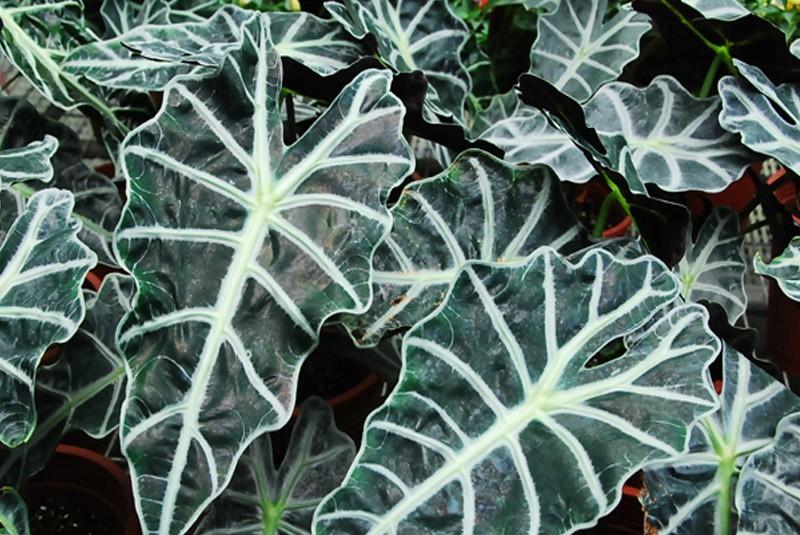
Alokazia Amazonica
Alocasia Sander is a tall species.Its height is up to 2 m, the length of the thyroid elongated dark green leaves with a glossy sheen is about 40 cm, the width is up to 15-20 cm. The leaves are outlined with a white border along the edge, the veins are also highlighted in white.
Large-root alokazia (thick-stemmed, Indian, Arma) is practically unpopular in Russia. Its height is up to 2 m at home, in nature - up to 5 m. Leaves are long-petiolized, large, up to 1 m, light green.
The variety Dragon (the second name is Dragon skin) is popular and textured. Its leaves are heart-shaped, pointed towards the end, of a very unusual color, reminiscent of dragon skin. The leaf plate is light green in color with a pronounced metallic sheen. The flower is less than 1 m in height, the leaves drooping due to their weight, which the cuttings cannot hold.

Dragon Skin Variety
Bambino is a hybrid variety of alocasia, very compact, only 40-60 cm high. Leaves are dark green narrow with white veins.
Alokazia Polly is a decorative leafy hybrid loved by flower growers. Its height is slightly more than half a meter. The stem is shortened, the leaves grow directly from the root rosette, their length is about 50 cm, width is 20 cm. The dark green glossy color with bright white veins and jagged edges looks impressive. Home care for Polly's alocasia is not very difficult, for which she attracted lovers of indoor plants.

Alocasia polly
There are many other popular varieties of alocasia: Lauterbachiana (Lauterbach, Lotherbachiana), Corazon, Sarian, Kukulata, Kupreya, Macroriza. Thanks to such a variety, everyone can choose a flower to their liking and the most suitable for the interior and size of the room.
For your information! Alokazia krupnokornevischaya listed in the Guinness Book of Records for its incredibly large leaves.
Home care
It is worth taking more care of this plant, as it is quite finicky. He needs warmth, as well as good hydration, in addition, he must be transplanted after purchase.
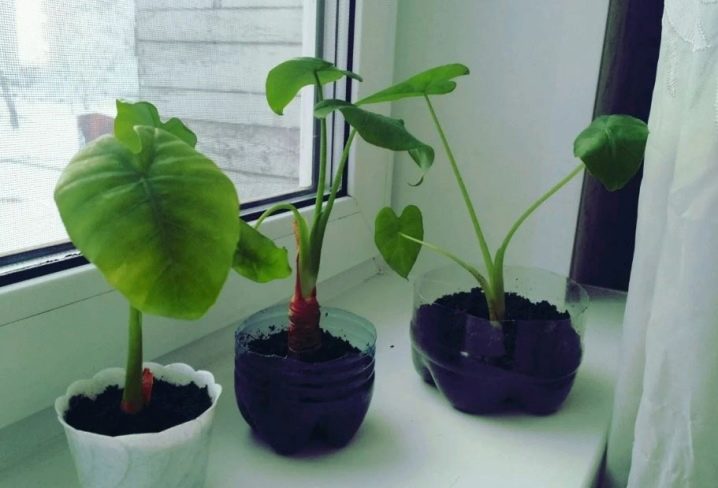
Temperature and humidification
This plant does not tolerate heat and cold very well. Therefore, in winter, the temperature should not drop below +17 degrees, and in summer, rise above +27 degrees. In addition, the humidity should be within 50 percent. To do this, you can put a flowerpot near a small aquarium or a small container of water. In addition, you need to watch so that there are no drafts, and also monitor temperature changes that the plant does not tolerate at all.
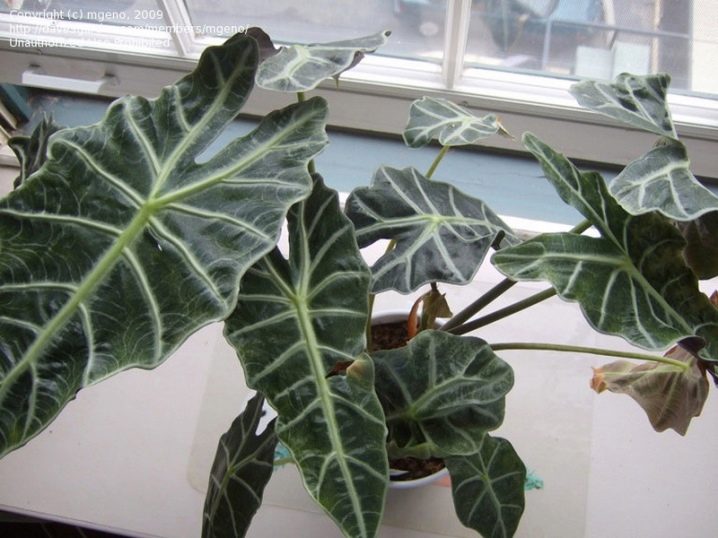
Lighting
Although alocasia does not like shade, it is still better not to place the flower in direct sunlight. In some cases, this can even lead to burns, because its leaves are very sensitive. It is necessary that the light be diffused.
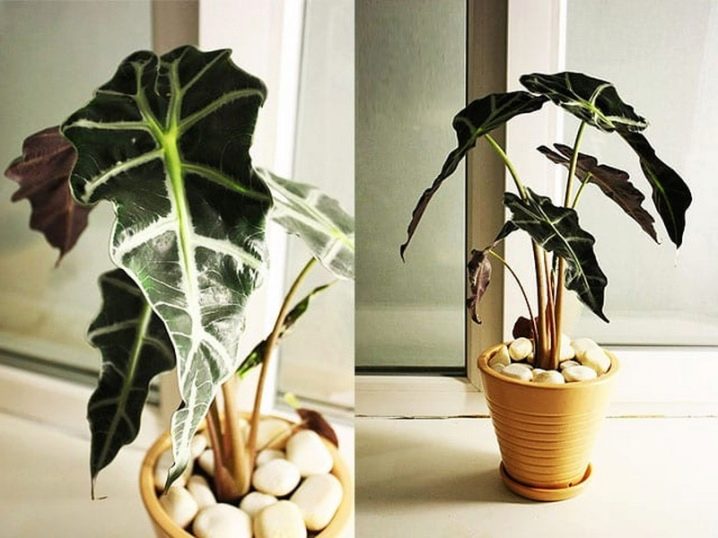
Watering
Watering this unusual plant is necessary often, but not too abundantly. In addition, the water must be warm and soft or settled for one day. If, after watering, water runs out into the stand, you should not leave it there, but you just need to pour it out.
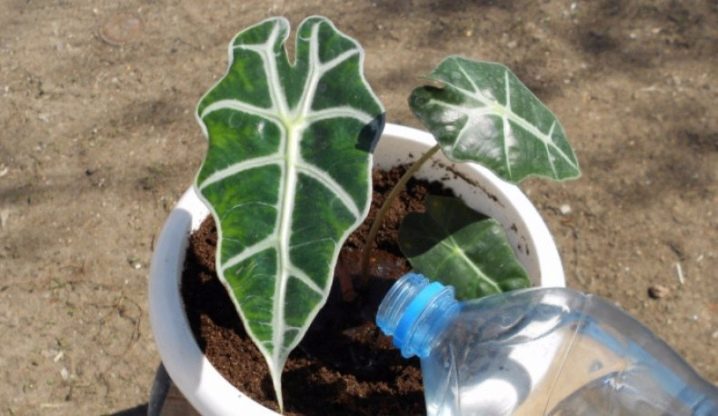
Fertilizer
It is imperative to feed such a plant. It is especially useful to do this in winter, while fertilizer should be applied once a month. But in the spring and summer, it should be fertilized up to 2 times a month. It will be better if fertilizers are selected from potassium and nitrogen.
This is important, especially if new leaves do not grow on the flower for a long time.
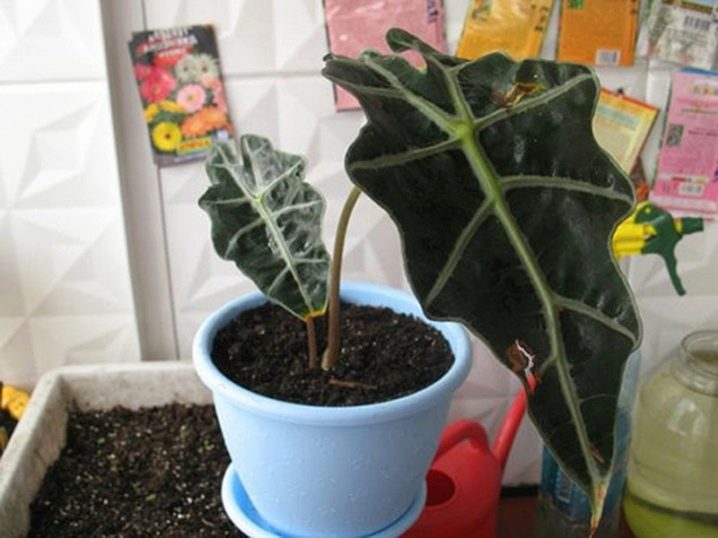
Transfer
This procedure is done not so often. For an adult plant, it will be enough to transplant once every 3 years, but young alocasia is transplanted only when necessary. It is best to take the soil that was purchased in flower shops. However, you can make the substrate yourself. To do this, you need to take the following components:
- 1 part deciduous humus;
- 1 part coarser sand;
- 1 part peat;
- 1 part of turf land.

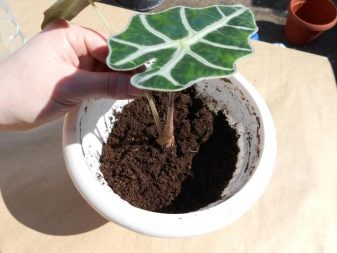
It is best to buy a flowerpot plastic and rather high.In addition, each time the pot should be several centimeters higher than the previous one. When transplanting this handsome man, you should not cut it off, unless you remove only old leaves. And also it is necessary not to forget about the newly purchased flower, it must be transplanted. However, there is no need to rush into this. This should be done only after 1 week, when the plant will take root a little in the new house, that is, the adaptation period will pass. Do not forget about gloves when making a transplant, since it must be remembered that the plant is poisonous.


